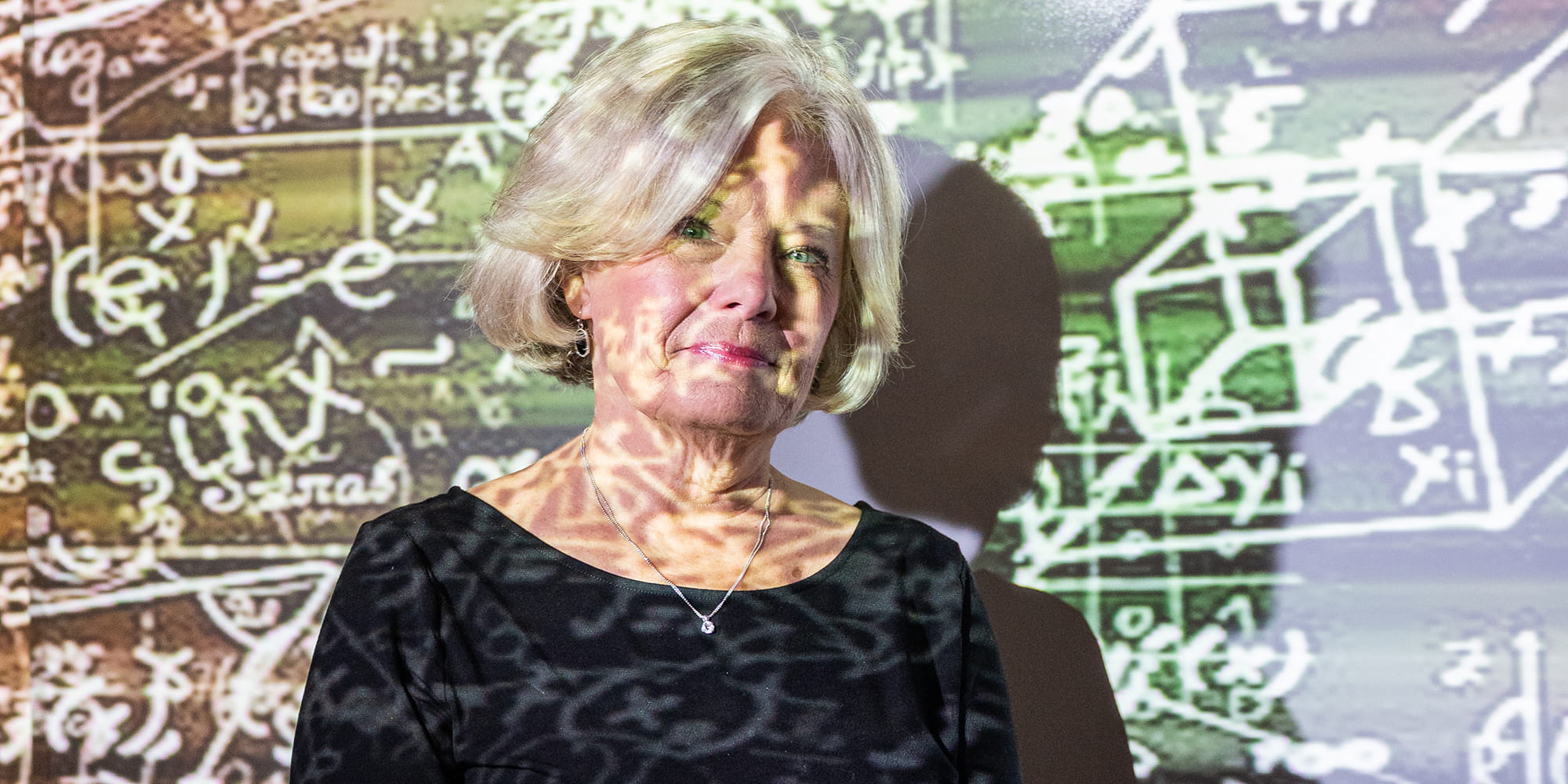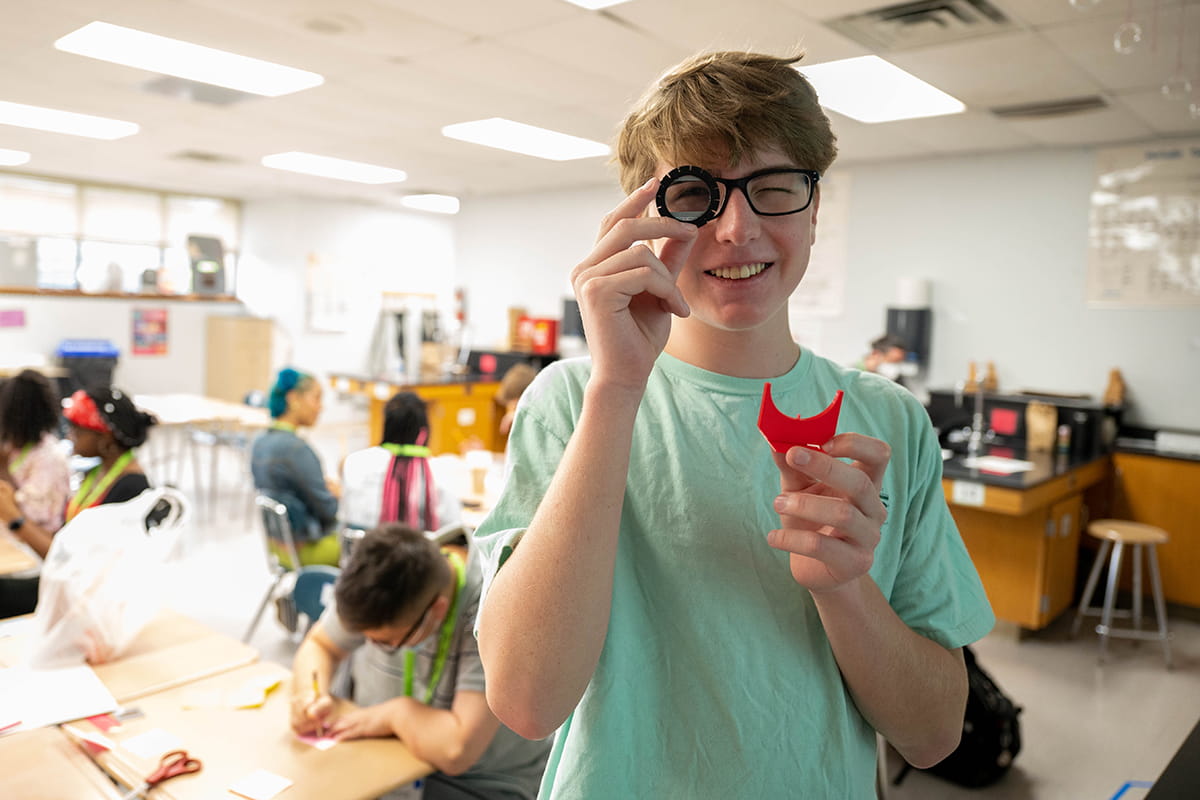Quantum trailblazer

Weeks into summer break, a classroom door opened onto a quiet hallway at Martin High School in Arlington, where a crowd of students waited.
What is something that has confused you this week?” asked Victor Cervantes, an alumnus of the UTeach program at The University of Texas at Arlington and an AP physics teacher. Students wrote their answers on sticky notes and stuck them to butcher paper hanging from the wall. Many of the colorful papers read “wave-particle duality.”
A group of more than 50 high school students and teachers was meeting to attend workshops in quantum information science (QIS) led by Karen Jo Matsler, assistant professor in practice at UTA. Many of the weeks lessons were guiding them through uncharted territory.
In 2021, the National Science Foundation awarded Matsler and collaborators a nearly $1 million grant to launch Quantum for All, a three-year QIS program for high school teachers. Key to workforce preparation, quantum principles intersect with numerous industries, impacting global communication methods, technology, innovation, health care, issues of national security and more. As an emerging field, QIS is excluded from many high school courses.
Quantum skills are integral to the development of a globally competitive workforce,” Matsler said. “If students have never heard of these concepts before they enter college, they likely won’t choose to study them at advanced levels.

Open to high school teachers from across the country, the program capitalizes on familiar content areas in instructors’ existing curricula and teaches them how to incorporate quantum principles into lesson plans. During summer breaks, participants gather for intensive workshops where they practice teaching the new subject.
At the beginning of the day, Matthew Quiroz, a physics and astronomy teacher at Ysleta High School in El Paso, Texas, gathered materials from a 3D printer. The day before, the students were given parameters for an experiment and told to design and 3D-print the tools they lacked.
Jonathan Lewis, a junior in Martin High School’s STEM academy, paired with a friend to lead his cohort’s design.
“We needed to design a rotating stand to hold a small polarizer,” Lewis said. “Our group brainstormed ideas and then designed the 3D model in Tinkercad, a software I had never used. Going through the stages of this project has been a lot of fun.
Using the student-made tools, Quiroz guided the class through an experiment testing how varying polarizer angles affect the brightness of light. As students examined the polarization of photons, he introduced them to the quantum concepts of superposition, states and probability.
Matsler, a clear-eyed veteran with infectious enthusiasm, is the science teacher everyone wishes they had in high school. Throughout the morning she bounced between classrooms, cheering her pupils through lessons in physics, cryptography and coding.
Students on computers used the modeling software Glowscript to code a physics simulation, where two balls, one constant and one accelerating, traveled through space. Although both were released at the same time, the accelerating ball traveled farther and faster.
Are we having fun, y'all? she said.

Among students and teachers, the enthusiasm was palpable. Many instructors had traveled from across Texas and the southern United States to attend Matsler’s workshops. Jacqueline Edwards, a science teacher at McAdory High School in McCalla, Alabama, said studying quantum concepts reminded her that she and her colleagues are lifelong learners.
We are all learning about the process of trial and error,” she said. That's the essence of scientific inquiry. We don't fail, we just try again.”
Cori Davis, a biomedical science teacher in Martin High School’s STEM academy, discovered how to incorporate quantum information into her forensics curriculum.
Quantum principles have broad applications, Davis said. In our unit on forensic science, I can apply these lessons to how we understand projectile motion when examining bullet wounds and blood splatter.
Matsler argues that small modifications to lesson plans in math, chemistry, technology and other science and engineering courses enable teachers to easily integrate quantum theory into their syllabi.
Make no mistake, she said, quantum principles aren’t only important for physics teachers.
Most K-12 educators are not prepared to teach QIS because they didn’t study advanced physics in college,” Matsler said. “These workshops democratize quantum principles, making them accessible to teachers of a variety of science, technology, mathematics and engineering courses.”
--
The UTA College of Science, a Texas Tier One and Carnegie R1 research institution, is preparing the next generation of leaders in science through innovative education and hands-on research and offers programs in Biology, Chemistry & Biochemistry, Data Science, Earth & Environmental Sciences, Health Professions, Mathematics, Physics and Psychology. To support educational and research efforts visit the giving page, or if you're a prospective student interested in beginning your #MaverickScience journey visit our future students page.